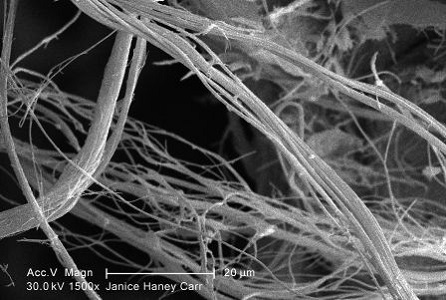Asbestos
The term asbestos refers to a group of fibrous minerals that have been mined and used extensively over the last century. Their tremendous strength and resistance to heat and chemicals have made them ideal for use in a wide variety of commercial products. By the early 1970s, more than 3000 different types of products contained asbestos, and over 800,000 metric tons of asbestos were used annually in the United States.
The increased popularity and use of asbestos coincided with an important and unfortunate discovery. When large amounts of asbestos fibers are inhaled into the lungs over many years, they can cause severe scarring and, in some cases, cancer. Researchers discovered that individuals exposed to large amounts of asbestos at work (asbestos miners, for example) had an increased risk of developing asbestosis (a disease that involves the scarring of lung tissue), lung cancer and mesothelioma, a rare form of cancer involving the thin membrane that surrounds the lungs and other internal organs.
The likelihood of developing asbestosis, lung cancer and mesothelioma increases with the number of asbestos fibers that are inhaled, and it typically takes prolonged exposure to high levels of fibers to get these diseases. Although most experts don't believe that prolonged exposure to small amounts of asbestos and even large one-time exposures are likely to cause significant health problems, minimizing exposure to asbestos is prudent.
Because asbestos is used in a variety of building materials and construction products, many people worry about the potential for exposure to asbestos in their home. But the mere presence of asbestos-containing products isn't necessarily dangerous; The risk that they pose depends largely on their quantity and condition.
Although materials that are in good repair will not typically release fibers, they may do so if they're disturbed or damaged. That's why it's generally best not to disturb any material that you know contains asbestos and is in good condition. (Be aware that you can't tell if a material contains asbestos simply by looking at it. If there's any possibility that it does, you should treat the material as though it were asbestos or have a sample of it analyzed.) Also, just because asbestos is extremely durable, don't assume that it isn't susceptible to wear and tear. Known asbestos-containing materials should be inspected regularly for signs of damage.
If damaged asbestos-containing materials are discovered, it may only be necessary to repair them not remove them entirely. A sealant, for example, can sometimes be used to encapsulate asbestos fibers, or an airtight enclosure can be placed over or around them. In some cases, however, the best course of action is to remove them completely. But, keep in mind, disturbing asbestos poses the greatest risk of releasing fibers and may not be safe if the job is performed improperly. In fact, improper removal can create a hazard where none existed before. To ensure that the job is done right, hire only a certified asbestos contractor.
You May Be Interested In...
Links
- Asbestos Fact Sheet - Los Angeles County Department of Public Health
- Asbestos - U.S. Environmental Protection Agency
- Asbestos ToxFAQTM - Agency for Toxic Substances and Disease Registry
- Asbestos - National Institute for Occupational Safety & Health
- Asbestos Exposure and Cancer Risk - National Cancer Institute
- California Contractors State License Board - Asbestos Registrants' Database - State of California
- Asbestos - United States Department of Labor





